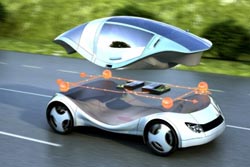Software Architecture for the Car of the Future

In vehicles built with this new technology, the driver assistance, safety, and infotainment features will mostly be installed as software instead of being managed in control units. This will reduce the current complexity of the ICT architecture and at the same time increase its power.
The partners intend to demonstrate the benefits of a centralized ICT architecture with two electric car prototypes. The recently launched project RACE (Robust and Reliant Automotive Computing Environment for Future eCars) is scheduled to run for three years and is being funded by Germany's Federal Ministry of Economics and Technology.
Today, drivers and vehicle occupants enjoy improved performance, comfort, and safety thanks to functions like the anti-lock braking system, Electronic Stability Program, active parking aid, emergency brake assistant, lane departure warning system, and proximity-controlled cruise control.
However, the associated ICT that has grown up in vehicles over many years is becoming increasingly complex. This is making the introduction of new features increasingly labor-intensive and expensive. The individual components are connected with many different data transmission systems, for example.
It is hardly possible to upgrade cars with new functions that weren't built in to the vehicles during the initial manufacturing process. Electromobility offers the opportunity to rework the ICT architecture and to quickly integrate new functions.
To this end, the partners want to bring together all the functions in a few central computers with a single bus system. The advantage here is that new systems would be installed via Plug&Play technology like on a PC – extra control units and wiring would no longer be necessary. The new architecture should also enable the vehicle to communicate with a future intelligent power grid and transport system and allow the development of completely new functions – such as an “autopilot” that could steer the vehicle autonomously in the distant future.
The ICT architecture is being implemented in two electric cars. For the “Evolution” prototype, the researchers will replace the existing vehicle technology step-by-step with new components for features such as autonomous parking or inductive charging. The “Revolution” prototype is being newly designed from the ground up.
The project partners are Siemens, TRW Automotive, AVL Software and Functions, fortiss, Institut ILS at the University of Stuttgart, the departments Software & Systems Engineering and Real-Time Computer Systems at the TU München, Fraunhofer Research Institution for Applied and Integrated Security (AISEC), and the RWTH Aachen (ACS/ISEA).
Media Contact
More Information:
http://www.siemens.com/innovationnewsAll latest news from the category: Automotive Engineering
Automotive Engineering highlights issues related to automobile manufacturing – including vehicle parts and accessories – and the environmental impact and safety of automotive products, production facilities and manufacturing processes.
innovations-report offers stimulating reports and articles on a variety of topics ranging from automobile fuel cells, hybrid technologies, energy saving vehicles and carbon particle filters to engine and brake technologies, driving safety and assistance systems.
Newest articles

Bringing bio-inspired robots to life
Nebraska researcher Eric Markvicka gets NSF CAREER Award to pursue manufacture of novel materials for soft robotics and stretchable electronics. Engineers are increasingly eager to develop robots that mimic the…

Bella moths use poison to attract mates
Scientists are closer to finding out how. Pyrrolizidine alkaloids are as bitter and toxic as they are hard to pronounce. They’re produced by several different types of plants and are…

AI tool creates ‘synthetic’ images of cells
…for enhanced microscopy analysis. Observing individual cells through microscopes can reveal a range of important cell biological phenomena that frequently play a role in human diseases, but the process of…





















